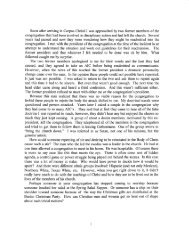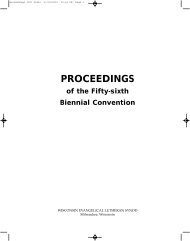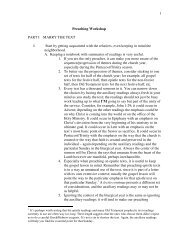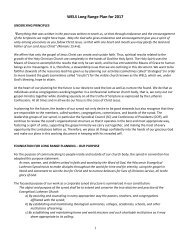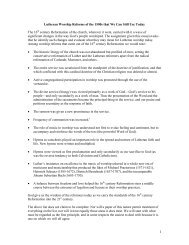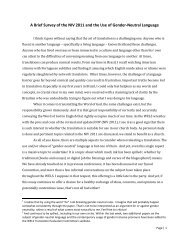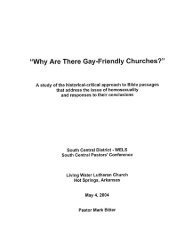A History of the WELS - The South Central District
A History of the WELS - The South Central District
A History of the WELS - The South Central District
You also want an ePaper? Increase the reach of your titles
YUMPU automatically turns print PDFs into web optimized ePapers that Google loves.
Budgetary Allotments” had three main parts or phases: “I. A Uniform System for Disseminating Information, II. A<br />
Uniform Method <strong>of</strong> Collecting for Synodical Budget, and III. A Uniform Method <strong>of</strong> Control.”<br />
According to <strong>the</strong> Michigan Plan <strong>the</strong> various activities and departments <strong>of</strong> Synod were to be divided into<br />
twelve convenient groups, one for each month, and that a placard was to be prepared for each department.<br />
<strong>The</strong>se placards would contain <strong>the</strong> total amount to be collected for each department per year, an illustration <strong>of</strong><br />
<strong>the</strong> department, an appropriate Scripture text, and <strong>the</strong> rate per communicant for each department. <strong>The</strong>se<br />
placards <strong>the</strong>n, were to be distributed to every congregation at regular intervals (quarterly, in sets <strong>of</strong> three) and<br />
displayed every month in a conspicuous place. <strong>The</strong> general finance committee was to prepare monthly bulletins,<br />
giving timely and colorful information, to accompany <strong>the</strong> placards. <strong>The</strong> pastors were <strong>the</strong>n requested to speak to<br />
<strong>the</strong>ir people on <strong>the</strong> subject <strong>of</strong> <strong>the</strong> placard at <strong>the</strong> beginning <strong>of</strong> <strong>the</strong> month. <strong>The</strong> pastors were free to do this in<br />
whatever way <strong>the</strong>y wanted (sermon, lecture at close <strong>of</strong> service, etc.). <strong>The</strong> pastors would also be informed on <strong>the</strong><br />
standing <strong>of</strong> <strong>the</strong>ir congregations (monthly by conference financial secretary) and <strong>of</strong> <strong>the</strong>ir districts’ standing<br />
(quarterly by district finance committee).<br />
In regard to <strong>the</strong> collecting for <strong>the</strong> synodical budget <strong>the</strong> Michigan Plan urged <strong>the</strong> introduction <strong>of</strong> monthly<br />
envelopes for Synod corresponding in design and wording to <strong>the</strong> placard <strong>of</strong> <strong>the</strong> month. <strong>The</strong>se envelopes were to<br />
be furnished by <strong>the</strong> Synod and <strong>the</strong> district finance committees were responsible for <strong>the</strong>m. Where <strong>the</strong> envelopes<br />
could not be introduced, uniformity in <strong>the</strong> method <strong>of</strong> collecting was urged. <strong>The</strong>se collections were to be<br />
submitted to <strong>the</strong> <strong>District</strong> Treasurer at <strong>the</strong> end <strong>of</strong> every month to avoid misappropriation <strong>of</strong> funds.<br />
Pastor Edgar Hoenecke was appointed <strong>the</strong> Secretary <strong>of</strong> <strong>the</strong> Michigan Plan. He edited <strong>the</strong><br />
bulletins produced in connection with <strong>the</strong> Plan. By May <strong>of</strong> 1935 he had printed 17 bulletins with a<br />
circulation <strong>of</strong> about 51,000, which was almost complete coverage. He continued printing <strong>the</strong> Bulletin<br />
until <strong>the</strong> Synod Convention <strong>of</strong> 1941 when he asked to be relieved as editor <strong>of</strong> <strong>the</strong> Bulletin, because he<br />
had been elected Executive Secretary <strong>of</strong> Indian Missions in October, 1940, and no longer had <strong>the</strong><br />
necessary time.<br />
Did <strong>the</strong> bulletins and placards, and <strong>the</strong> Bulletin, in o<strong>the</strong>r words, <strong>the</strong> Michigan Plan, help <strong>the</strong> financial<br />
situation <strong>of</strong> Synod? President John Brenner in <strong>the</strong> “Biennial Report <strong>of</strong> <strong>the</strong> President” in 1935 had this comment:<br />
“Many share our belief that <strong>the</strong> bulletins edited by Pastor Edgar Hoenecke have contributed much to <strong>the</strong><br />
increase in collections to be noted in every <strong>District</strong>.” A plan was also developed and adopted by <strong>the</strong> Synod to<br />
liquidate <strong>the</strong> debt. <strong>The</strong> Synod <strong>of</strong> 1935 resolved:<br />
That an earnest, concerted, co-operative effort be made during this biennium, to raise a sum<br />
sufficient to cover our present indebtedness, by urging individual pastors, teachers and laymen<br />
within our congregations to assume individual liability for sums <strong>of</strong> $100.00 or more, so that <strong>the</strong><br />
entire indebtedness may be liquidated within this present biennium; <strong>the</strong>refore, be it fur<strong>the</strong>r<br />
Resolved, that <strong>the</strong> Synod through its President, in conjunction with <strong>the</strong> Executive Committee <strong>of</strong><br />
its Board <strong>of</strong> Trustees, appoint a committee <strong>of</strong> three men to outline a definite program, in<br />
accordance with which this suggestion may be carried out as soon as possible. 28<br />
By <strong>the</strong> Synod <strong>of</strong> 1937 <strong>the</strong> Debt Retirement Committee was able to report that it had received<br />
subscriptions <strong>of</strong> $249,162.00 and cash remittances <strong>of</strong> $98,159.28. But this was not even half <strong>of</strong> <strong>the</strong> $640,000<br />
debt Synod had as <strong>of</strong> August 1, 1935 when <strong>the</strong> Debt Retirement Program was established. <strong>The</strong>refore, Synod<br />
decided to continue <strong>the</strong> program <strong>of</strong> debt retirement until every congregation in <strong>the</strong> Synod had participated<br />
according to its ability and until <strong>the</strong> whole debt had been wiped out. So far, 331 parishes were participating; 50<br />
parishes were unable to participate; 93 were at work, but had given no report <strong>of</strong> progress; 66 congregations had<br />
not reported; and 114 requested more time for solicitation.<br />
At <strong>the</strong> Convention <strong>of</strong> 1939 <strong>the</strong> Committee reported that after three and one-half years <strong>of</strong> work <strong>the</strong>y were<br />
still a bit short <strong>of</strong> <strong>the</strong> half-way mark. By May 7, 1939 <strong>the</strong> Committee had received $244,655.16 in cash<br />
remittances. By 1941 this amount had increased to $307,849.92.<br />
13<br />
28 Ibid., pp. 106-107.



